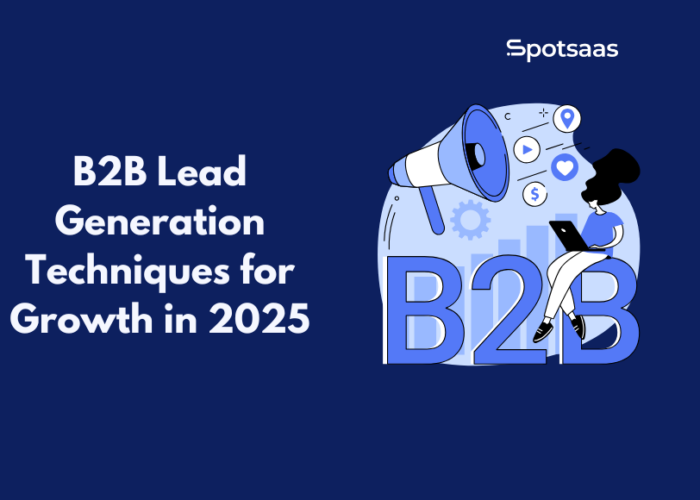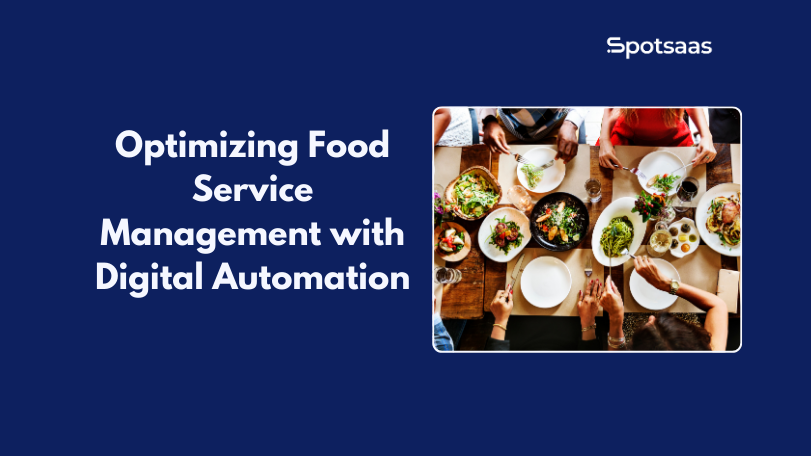A strong B2B lead generation strategy is essential for success. Unlike B2C, buyers take time to research, evaluate, and consult before purchasing. Businesses must prioritize trust-building, education, and personalized engagement.
Traditional cold calls and mass emails are ineffective—modern buyers expect value-driven interactions and relevant content. Companies that don’t adapt risk losing market share to more strategic competitors.
Ready to supercharge your lead gen campaign? Let’s dive in!
Key Takeaways
✅ Prioritize high-quality leads for better conversions.
✅ Use a multi-channel approach for maximum impact.
✅ Nurture leads consistently throughout long sales cycles.
✅ Leverage data and AI for precise targeting.
✅ Align sales and marketing to boost conversions.
What is B2B Lead Generation?
B2B lead generation is the process of attracting and engaging businesses that are potential customers for your product or service.
Unlike B2C, where companies market directly to consumers, B2B lead generation focuses on reaching decision-makers and industry professionals responsible for making purchasing decisions.
It involves building relationships, creating trust, and guiding prospects through a structured process that turns them into long-term customers.
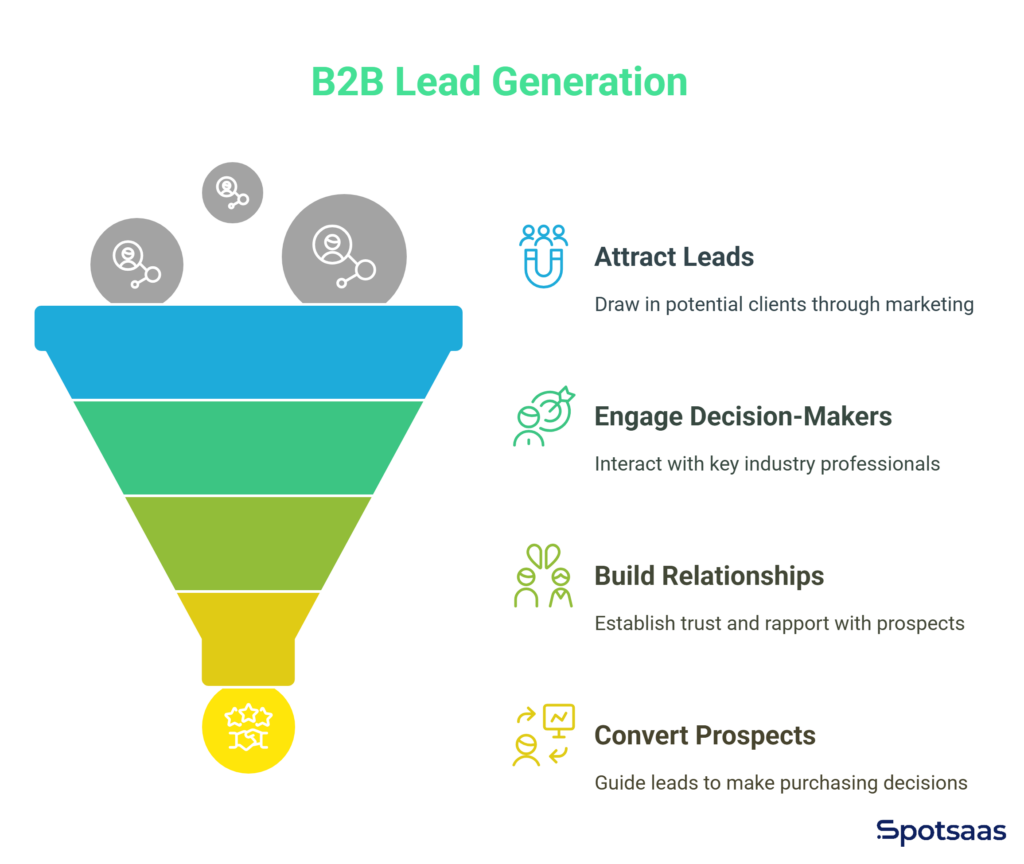
How Does B2B Lead Generation Work?
B2B lead generation follows a structured process to help businesses connect with the right audience and convert them into paying customers. Here’s how it works:
Identifying Target Customers
The first step is understanding who your ideal customers are. This includes defining characteristics like industry, company size, job roles, and specific challenges they face. By knowing your audience, you can create a targeted strategy that reaches the right people instead of wasting time on those who are unlikely to be interested.
Attracting Prospects
Once you know your audience, the next step is to get their attention. Businesses use various marketing channels, such as content marketing, search engine optimization (SEO), paid ads, and social media, to attract potential leads.
Sharing valuable insights, writing industry-related articles, and offering educational content can help position your business as a trusted source.
Capturing Lead Information
When potential customers show interest, the goal is to collect their contact details so you can stay in touch. This can be done through forms, sign-ups, webinars, or gated content like whitepapers and reports.
Offering something of value in exchange for their contact information encourages them to take the next step.
Nurturing Leads
B2B sales cycles tend to be longer, which means businesses need to stay engaged with prospects until they are ready to make a decision.
Lead nurturing involves sending helpful emails, sharing relevant case studies, engaging through LinkedIn, and providing solutions that address their needs. The focus should be on educating and building trust rather than pushing for an immediate sale.
Converting Leads
The final stage is turning potential leads into paying customers. This is where personalized product demos, free trials, or one-on-one consultations can make a difference.
Having a well-structured sales process helps guide prospects smoothly from interest to action, increasing the chances of closing deals and building long-term relationships.
Understanding B2B vs. B2C Lead Generation
Lead generation strategies vary significantly between B2B (Business-to-Business) and B2C (Business-to-Consumer) models. While both involve attracting and converting prospects, the process, audience, and sales cycle differ.
| Aspect | B2B Lead Generation | B2C Lead Generation |
|---|---|---|
| Target Audience | Businesses, decision-makers, and stakeholders | Individual consumers or mass audiences |
| Sales Cycle | Longer, involves multiple decision-makers | Shorter, often impulsive purchases |
| Decision-Making | Logical, research-driven, based on ROI | Emotional, influenced by brand and experience |
| Content Type | In-depth content: whitepapers, case studies, webinars | Short, engaging content: ads, videos, reviews |
| Marketing Channels | LinkedIn, email, industry events, SEO-driven blogs | Social media, influencer marketing, paid ads |
| Customer Relationship | Long-term, requires nurturing and trust-building | Transactional, focused on quick conversions |
Top B2B Lead Generation Strategies
B2B lead generation involves attracting and engaging businesses that need your products or services. Unlike B2C, B2B buyers make slower, research-driven decisions involving multiple stakeholders.
Success requires a structured approach to building trust, delivering value, and nurturing leads over time.
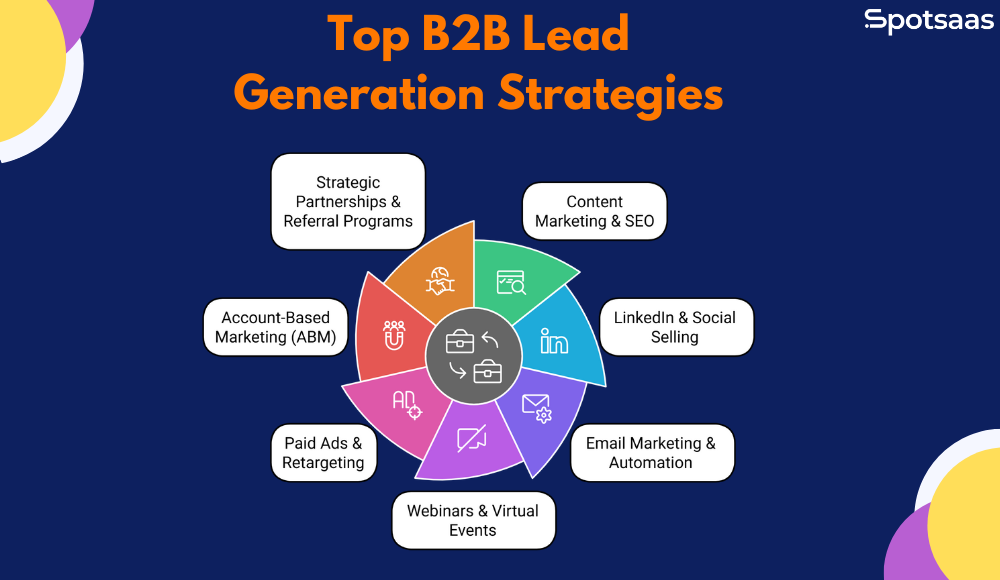
Content Marketing & SEO
Content marketing, combined with SEO, is one of the most effective ways to attract and convert leads over time. By creating high-quality, informative content—such as blogs, whitepapers, and case studies—you demonstrate thought leadership and build trust with your target audience.
- SEO ensures your content ranks highly on search engines: This visibility places your solutions in front of decision-makers actively searching for products or services like yours.
- Blogging and whitepapers offer detailed guidance: Blogs provide timely insights and updates, while whitepapers and reports dive deeper into industry challenges, offering practical, data-backed solutions.
- Case studies showcase real-world results: By highlighting success stories, you prove your ability to solve the problems prospects face.
- Gated content captures high-quality leads: Exclusive resources such as in-depth reports, e-books, or proprietary research entice potential customers to exchange their contact information, making it easier to follow up with them.
Content marketing and SEO, when done right, create a long-term, sustainable pipeline of informed, qualified leads.
LinkedIn & Social Selling
LinkedIn is a central hub for B2B lead generation. As the world’s largest professional network, it allows companies to connect with key decision-makers in a targeted, authentic way.
- Optimized LinkedIn profiles: A polished profile increases credibility and establishes trust, making prospects more likely to engage with you.
- Engaging content builds relationships: Regularly posting valuable articles, sharing industry insights, and participating in conversations demonstrates your expertise and keeps you top-of-mind.
- LinkedIn Ads can boost reach: Highly targeted ad campaigns allow you to reach specific roles, industries, or account lists, making it easier to generate interest.
- Sales Navigator enables smarter outreach: By identifying the right contacts, you can send personalized messages to key decision-makers, increasing the chances of meaningful engagement.
Overall, LinkedIn and social selling create a more personal, one-to-one connection with leads, encouraging them to engage and move further down the funnel.
Email Marketing & Automation
Email marketing is an incredibly versatile tool for B2B lead generation. It allows you to engage directly with prospects in a cost-effective way while tailoring the content to their specific needs.
- Personalized campaigns are more effective: Sending emails that address a lead’s particular challenges or interests makes the communication more relevant, increasing open and click-through rates.
- Automated lead nurturing sequences keep prospects engaged: By setting up a sequence of emails that deliver valuable content—such as guides, product updates, or testimonials—you can keep the conversation going without manually sending each message.
- Re-engagement campaigns revive cold leads: For prospects who haven’t engaged recently, you can send new insights, updated offers, or helpful resources to reignite their interest.
With the right email strategy, you can nurture leads at scale, ensuring they stay informed and gradually move closer to making a purchase decision.
Webinars & Virtual Events
Webinars and virtual events create a unique opportunity to engage directly with your audience, share valuable knowledge, and establish your company as a thought leader.
- Expert-led discussions enhance trust: By inviting industry experts or hosting internal specialists to discuss relevant topics, you demonstrate authority and deepen trust with your audience.
- Live Q&A sessions encourage participation: Allowing attendees to ask questions in real time makes them feel heard and gives you a chance to address specific concerns, which builds a stronger connection.
- Recordings keep generating leads post-event: Even after the live session, sharing a recording on your website or social channels allows you to continue gathering leads from people who couldn’t attend.
Webinars not only deliver educational value but also help you engage your audience in a more interactive and meaningful way, turning attendees into warm leads.
Paid Ads & Retargeting
Paid advertising can deliver fast results by placing your business in front of prospects who are actively looking for solutions.
- Google Ads capture high-intent search traffic: When potential customers search for products or services, your ads appear at the top of search results, driving qualified visitors to your site.
- LinkedIn Ads target decision-makers: By running ads that reach specific job titles, industries, or even company lists, you can ensure your messaging is seen by the right people at the right time.
- Retargeting campaigns re-engage past visitors: Prospects who have visited your website but didn’t convert can be reminded of your offering through retargeted ads. This keeps your brand top-of-mind and increases the likelihood of conversion.
Overall, paid ads and retargeting strategies provide a quick, reliable way to generate leads and maintain visibility among potential customers.
Account-Based Marketing (ABM)
Account- Based Marketing focuses on high-value accounts rather than broad audiences, ensuring that your resources and efforts are directed toward the most promising leads.
- Targeted campaigns reach decision-makers at key accounts: ABM allows you to create personalized messaging for specific companies, making your communications more relevant and impactful.
- Sales and marketing alignment ensures cohesive outreach: By working closely together, sales and marketing teams can develop unified strategies that address the needs of high-value accounts at every stage of the buyer’s journey.
- Personalized content increases engagement: Tailored webinars, case studies, or videos for a particular account demonstrate your commitment to solving their unique challenges.
ABM helps you build deeper, more meaningful relationships with your most important prospects, leading to higher conversion rates and larger deals.
Strategic Partnerships & Referral Programs
Strategic partnerships and referral programs leverage existing relationships to generate new leads, often at a lower cost than traditional marketing efforts.
- Leveraging established relationships builds trust quickly: Referrals from known and trusted sources make prospects more likely to trust your company from the start.
By fostering partnerships and encouraging referrals, you create a steady flow of high-quality leads that already have a degree of trust in your offering. - Partnerships with complementary businesses expand your reach: By teaming up with companies that serve a similar audience, you can tap into their customer base and gain exposure to new prospects.
- Incentives encourage customers to refer your services: Offering discounts, rewards, or exclusive benefits for referrals motivates your clients to recommend your business to others.
Metrics to Track Lead Generation Success
Measuring the performance of your lead generation efforts is crucial to ensuring that your campaigns are effective and cost-efficient.
By monitoring the right metrics, you gain valuable insights into which strategies are working, where improvements are needed, and how you can allocate resources more effectively.
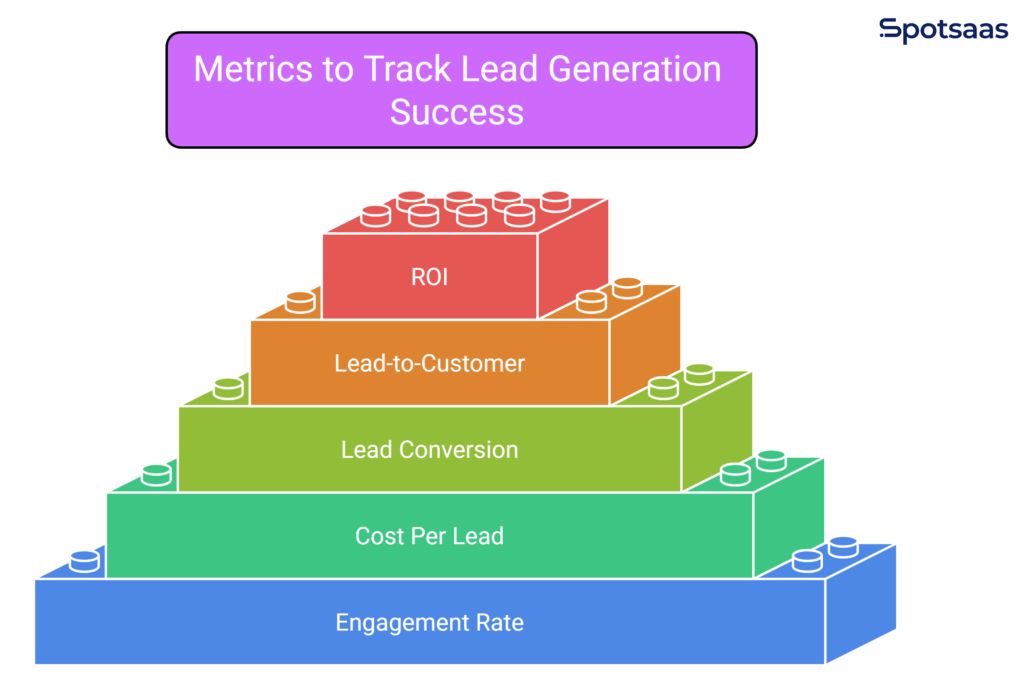
Below are some key metrics to consider, along with a closer look at what they reveal:
Lead Conversion Rate
This metric reflects the percentage of leads that ultimately convert into paying customers. A higher conversion rate indicates that the quality of your leads is strong and that your sales process is effective.
By examining this metric, you can identify any gaps in your funnel, adjust your targeting, and refine your follow-up strategies to move prospects through the pipeline more efficiently.
Cost Per Lead (CPL)
CPL measures how much you’re spending to acquire each lead. It helps you understand the financial efficiency of your lead generation efforts. By keeping CPL as low as possible while maintaining lead quality, you can ensure that your campaigns deliver better returns.
This metric can also highlight channels or campaigns that may be more expensive than others, prompting you to reallocate budgets to higher-performing strategies.
Lead-to-Customer Ratio
The lead-to-customer ratio shows how effectively your team converts qualified leads into actual customers. A high ratio suggests that your marketing and sales efforts are well-aligned and that your lead qualification process is solid.
If the ratio is low, it may indicate issues such as targeting the wrong audience, insufficient nurturing, or gaps in the sales process that need to be addressed.
Return on Investment (ROI)
ROI provides a comprehensive view of the profitability of your lead generation efforts. By comparing the revenue generated from leads to the costs incurred in acquiring them, you can determine whether your strategy is financially sustainable.
Monitoring ROI helps you make data-driven decisions about which campaigns to scale up, which ones to tweak, and which ones to discontinue.
Engagement Rate
Engagement rate measures how actively leads interact with your content—whether it’s opening emails, clicking links, downloading resources, or attending webinars. A high engagement rate indicates that your content is resonating with your audience and that your nurturing efforts are effective.
On the other hand, a low engagement rate may signal the need to improve your messaging, provide more valuable content, or adjust the frequency of outreach.
Lead Scoring Process Overview
Lead scoring is a systematic approach to identifying the most valuable prospects within your pipeline. By assigning points based on behaviors and qualifying criteria, businesses can focus their sales efforts on leads with the highest potential for conversion, saving time and improving efficiency.
| Lead Scoring Process | Description |
|---|---|
| Assign Points | Assign points based on lead behavior, such as website visits, content downloads, or form fills. |
| Qualify Leads | Evaluate leads using criteria like company size, job title, industry, or engagement level. |
| Segment Leads | Categorize leads into hot, warm, and cold groups for more effective, personalized follow-ups. |
| Key Takeaway | Lead scoring ensures sales teams prioritize leads with genuine interest, improving conversion rates. |
B2B Lead Generation Tools to Streamline Growth
When it comes to B2B lead generation, using the right tools can make a significant difference in how efficiently you attract, engage, and convert prospects.
Here’s a closer look at some of the most effective tools and how they contribute to streamlining your lead generation process:
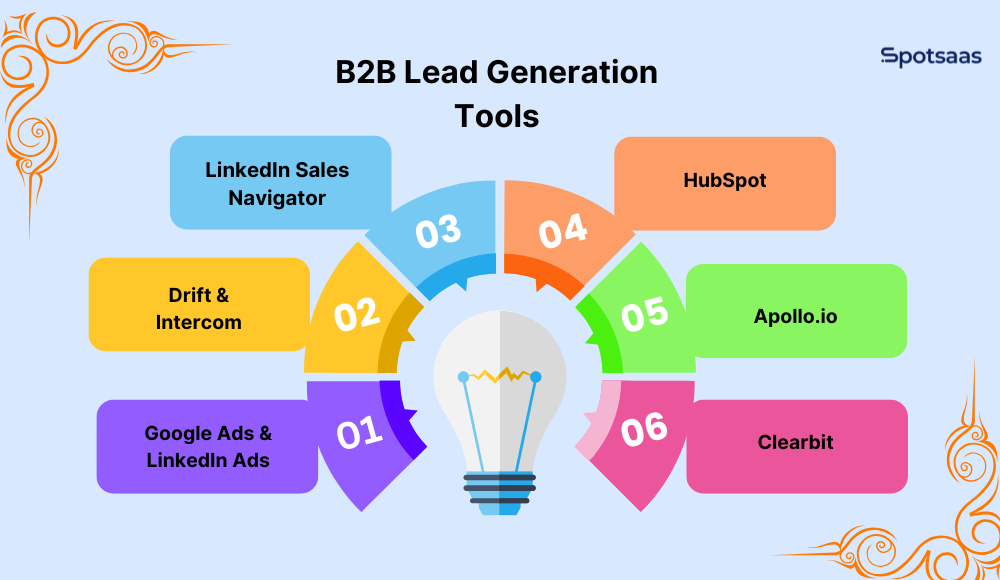
LinkedIn Sales Navigator
LinkedIn Sales Navigator is a powerful tool for identifying and engaging with key decision-makers. By using advanced search filters, you can zero in on prospects that match your ideal customer profile, such as specific job titles, industries, or company sizes.
Additionally, the platform provides real-time updates on your prospects’ LinkedIn activity, allowing you to personalize your outreach and build more meaningful relationships. The tool’s InMail functionality also enables you to contact leads directly, making it easier to start conversations and generate new opportunities.
HubSpot
HubSpot’s comprehensive CRM and marketing automation platform is a staple for many B2B companies. It centralizes all your lead data, making it easy to track interactions, segment your audience, and tailor your campaigns.
HubSpot also offers tools for email marketing, lead scoring, and analytics, giving you full visibility into your sales funnel. Its ability to integrate with other platforms ensures a seamless experience, helping you manage leads more effectively, improve engagement, and ultimately increase conversions.
Apollo.io
Apollo.io uses AI to supercharge your prospecting efforts. This platform not only helps you find high-quality leads, but also automates outreach and follow-ups, saving your sales team valuable time.
Its AI-driven suggestions can help you craft more personalized messages and optimize the timing of your outreach. Additionally, Apollo.io provides actionable insights into your prospects’ behavior, enabling you to refine your approach and improve conversion rates.
Clearbit
Clearbit specializes in enriching your lead data by pulling in additional information about your prospects. It can provide details like company size, industry, location, and even technologies used—giving you a more complete view of who you’re targeting.
By improving data accuracy and adding context, Clearbit helps you better segment your leads, craft highly relevant messaging, and increase the effectiveness of your campaigns.
Google Ads & LinkedIn Ads
Paid advertising platforms like Google Ads and LinkedIn Ads allow you to target high-intent prospects who are actively searching for solutions or fit your ideal customer profile.
Google Ads enables you to capture leads directly from search results, while LinkedIn Ads helps you reach professionals based on their job titles, company size, and industry. By using these paid channels, you can quickly scale your reach, attract qualified leads, and drive immediate results.
Drift & Intercom
Conversational marketing platforms like Drift and Intercom help you engage website visitors in real time. By using chatbots and live chat tools, these platforms can answer questions, provide product information, and guide prospects toward conversion.
Drift and Intercom also allow you to personalize conversations based on user behavior and lead data, creating a more interactive and engaging experience. The result is a faster, more efficient way to capture leads and move them through the sales funnel.
ZoomInfo
ZoomInfo is a leading market intelligence platform that provides detailed information on companies and their decision-makers. With a vast database of verified contact data, ZoomInfo helps you identify key prospects, understand their organization’s structure, and find the best points of contact.
This detailed information enables more targeted outreach, higher response rates, and a stronger pipeline of qualified leads. Additionally, ZoomInfo integrates with popular CRM systems, making it easy to manage and track leads throughout the sales process.
Lead Generation Tools Comparison
This table provides an overview of essential B2B lead generation tools, detailing their primary uses and key benefits. It highlights how each tool contributes to improving lead quality, streamlining outreach, and enhancing overall sales performance.
| Tool | Primary Use | Key Benefit |
|---|---|---|
| LinkedIn Sales Navigator | Finding and engaging decision-makers | Advanced filters, direct outreach via InMail |
| HubSpot | CRM and marketing automation | Centralized data, lead scoring, detailed analytics |
| Apollo.io | AI-powered prospecting | Automated outreach, data-driven insights |
| Clearbit | Lead data enrichment | More accurate segmentation, tailored messaging |
| Google Ads & LinkedIn Ads | Paid lead generation | Precise audience targeting, immediate traffic |
| Drift & Intercom | Conversational marketing | Real-time engagement, personalized user experiences |
| ZoomInfo | Market intelligence and prospecting | Verified contact data, detailed company insights |
Next Steps in B2B Lead Generation
A strong B2B lead generation strategy doesn’t stop with just creating campaigns. To achieve long-term success, businesses need to implement the most relevant strategies, leverage efficient tools, and continually refine their approach.
With the right steps in place, companies can consistently attract, engage, and convert valuable leads.
✅ Implement strategies aligned with your goals:
Identify the most effective approaches—like content marketing, paid advertising, or ABM—that directly support your business objectives. This ensures you focus on high-impact tactics rather than spreading your efforts too thin.
✅ Leverage the right tools for efficiency and scale:
Adopt solutions such as HubSpot, LinkedIn Sales Navigator, or ZoomInfo to streamline processes, better qualify leads, and quickly scale your campaigns. These tools help your team spend more time building valuable relationships and less time on repetitive tasks.
✅ Continuously refine your lead generation approach:
Regularly review key metrics—such as conversion rates, cost-per-lead, and lead quality—to identify what works and what needs improvement. Making data-driven adjustments over time keeps your pipeline filled with engaged, high-value prospects.
✅ Consider a customized strategy for optimal results:
If you’re unsure where to start, collaborating with experts to develop a tailored lead generation plan can unlock new growth opportunities and ensure long-term success.
Conclusion
A robust B2B lead generation strategy involves more than simply reaching out to as many prospects as possible. It requires a deep understanding of the target audience, careful selection of tools, and a deliberate multi-channel approach.
By relying on data-driven insights, creating personalized engagement strategies, and ensuring that sales and marketing are aligned, businesses can transform lead generation from a challenge into a strategic opportunity that drives sustainable growth.
Frequently Asked Questions
What are some highly effective B2B lead generation ideas?
Some highly effective B2B lead generation ideas include creating informative content, utilizing social media platforms, attending industry events, offering free trials or demos, and engaging in targeted email marketing.
How can I create informative content for B2B lead generation?
You can create informative content by publishing blog posts, whitepapers, case studies, or videos that provide valuable insights and solutions to the challenges faced by your target audience.
Is it important to utilize social media platforms for B2B lead generation?
Yes, utilizing social media platforms is important for B2B lead generation as it allows you to reach a wider audience, engage with potential leads directly through targeted ads or posts, and build brand awareness and credibility.
Should I attend industry events for B2B lead generation?
Attending industry events provides opportunities to network with potential leads and establish meaningful connections. It allows you to showcase your products or services and gain visibility within your target market.
How can targeted email marketing be an effective strategy for B2B lead generation?
Targeted email marketing involves sending personalized emails tailored to specific segments of your audience based on their interests or previous interactions with your company. This approach can help nurture leads and increase engagement levels effectively.

